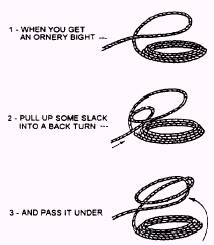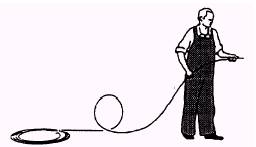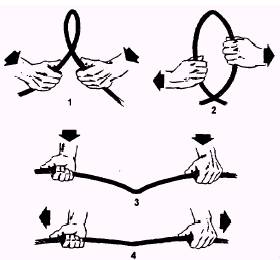Handling and Care of Wire Rope
To render safe, dependable service over a maximum period of time, you should take good care and upkeep that is necessary to keep wire rope in good condition. Various ways of caring for and handling wire rope are described below. COILING AND UNCOILING.- Once a new reel has been opened, it may be coiled or faked down, like line. The proper direction of coiling is counterclockwise for left lay and clockwise for right lay wire rope. Because of the general toughness and resilience of wire, it tends now and then to resist being coiled down. When this occurs, it is useless to fight the wire by forcing down the turn because it will only spring up again. But if it is thrown in a back turn, as shown in figure 6-39, it will lie down properly. A wire rope, when faked down, will run right off, like line; but when wound in a coil, it must always be unwound.
Wire rope tends to kink during uncoiling or unreeling, especially if it has been in service long. A kink can cause a weak spot in the rope that wears out quicker than the rest of the rope.

Figure 6-39.- Throwing a back turn.
A good method for unreeling wire rope is to run a pipe or rod through the center and mount the reel on drum jacks or other supports so the reel is off the ground, as shown in figure 6-40. In this way, the reel will turn as the rope is unwound, and the rotation of the reel helps keep the rope straight. During unreeling, pull the rope straightforward, and avoid hurrying the operation. As a safeguard against kinking, NEVER unreel wire rope from a reel that is stationary.
To uncoil a small coil of wire rope, simply stand the coil on edge and roll it along the ground like a wheel, or hoop, as also shown in figure 6-40. NEVER lay the coil flat on the floor or ground and uncoil it by pulling on the end, because such practice can kink or twist the rope.
KINKS.- One of the most common forms of damage resulting from improper handled wire rope is the development of a kink. A kink starts with the formation of a loop, as shown in figures 6-41 and 6-42.
A loop that has not been pulled tight enough to set the wires or strands or the rope into a kink can be removed by turning the rope at either end in the proper direction to restore the lay (fig. 6-43). If this is not done and the loop is pulled tight enough to cause a kink (fig. 6-44), the kink will result in irreparable damage to the rope (fig. 6-45).

Figure 6-40.- Unreeling wire rope (left); uncoiling wire rope (right).

Figure 6-41.- Improper handling.

Figure 6-42.- Wire rope loop.

Figure 6-43.- The correct way to take out a loop in a wire rope.

Figure 6-44.- Wire rope kink.

Figure 6-45.- Kink damage.
Kinking can be prevented by proper uncoiling and unreeling methods and by the correct handling of the rope throughout its installation.







